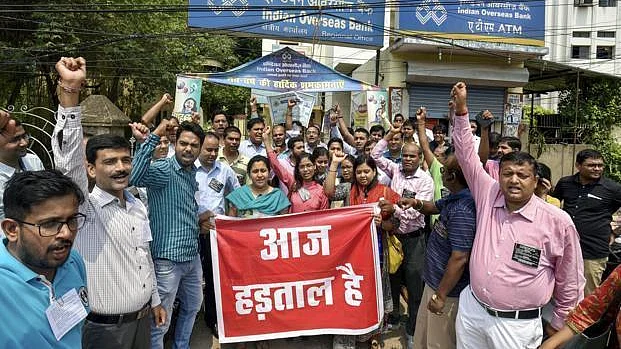2 bank strikes in a week: What are they about?
There have been 5 bank strikes in 2018. Employees are opposing mergers as they think the govt, instead of reviving individual banks by going after defaulters, is instead moving to privatise the banks

Some strikes stand out as unique in terms of their overall impact. Take the case of the December 26 strike by a million bank employees. Disrupting nearly 30 lakh cheque clearances worth anywhere between ₹20 lakh and ₹25 lakh crore in the estimates of bank Union leaders and much more in terms of online transactions, it is akin to a de facto mini-general strike with huge losses all around.
And mind you, the loss is not notional and just a matter of delay of business by one day. A leading chartered accountant in Chennai explains: “For a street-corner kirana shop, it might not be a big loss if the same customer comes and buys the next day. But for a big e-commerce firm, loss of transactions and payments on a particular day would count as net loss for the account books; it hardly matters even if the same customers were to book the same orders and pay online the next day. For book-keeping purposes, a day’s loss is a day’s loss. It is akin to cinema halls going without screening a movie on a particular day. Even if the same viewers come and watch the same movie the next day, it doesn’t make up for the previous day’s loss”.
On December 21, 2018, bank officers had held another successful strike on the issues of their wage revision demand and against the Indian Banks’ Association’s (IBA) divisive tactics, thus puzzling the business community with two successive bank strikes within a week. The bank officers are graded into seven layers and the IBA was first arguing that they would negotiate the wages of only the first three levels of officers and not those of level four to seven as they are executives. By joining the December 26 strike too, the bank officers successfully forced the IBA to concede their demand. As officers today outnumber clerks not only in private banks but in most of the PSBs, they brought banking to a standstill.
The bank officers are demanding a floor-level minimum wage of ₹57,000 per month for Grade 1 entry-level bank officers. The bank Unions have shown the Seventh Pay Commission scale for government officers in support of their demand
The strike marked the broadest confluence. From peons and clerks to executives, all stood united. Besides employees of public sector banks, those of Regional Rural Banks too joined in, demanding that IBA should implement the Supreme Court’s directive on extending the PSBs pension scheme to them also. Cooperative bank employees also participated with their demands, and even retired bank employees took part in demonstrations in large numbers voicing their grievances over anomalies in their pensions. The main demand, however, was against banks’ merger.
The bank officers are demanding a floor-level minimum wage of ₹57,000 per month for Grade 1 entry-level bank officers. The bank Unions have shown the Seventh Pay Commission scale for government officers in support of their demand.
BJP spokespersons argue that in view of the NPAs crisis, the government’s latest offer of 8% is quite justified. But, this 8% is on the aggregate salary bill similar to the ‘cost to the company’ and then this would be apportioned in different proportions between clerks and officers and between basic pay and other allowances and ultimately the increase in take-home pay would be marginal.
There have been five bank strikes in 2018. VSS Sastry, a retired bank employee, says, “It is a game of low-key attrition. The government and the IBA hope that they could tire the bank employees out through delaying tactics and force them into accepting a low hike. The unions are cleverly avoiding an immediate showdown and thus giving a handle to a rabid rightwing government for a major crackdown. Moreover, it is also a war of perception and winning public support by taking care not to cause undue hardship to the people”.
Sastry further explains that the wage issue cannot be settled through wildcat strikes. “It is a structured collective bargaining process and unions too have to play the game according to the ground rules and outsmart the IBA.”
Vasant Rai, president of the Karnataka Bank Employees Federation, says, “We are opposing mergers because banks with high NPAs are dumped on viable banks and hence even SBI is showing operational loss. We have strong suspicion that the government, instead of reviving individual banks by going after defaulters, is doing this to ultimately privatise the banks. So the strike was to save the public sector banking industry”.
The bank employees are also joining the two-day general strike on January 8 and 9, 2019.
Follow us on: Facebook, Twitter, Google News, Instagram
Join our official telegram channel (@nationalherald) and stay updated with the latest headlines
